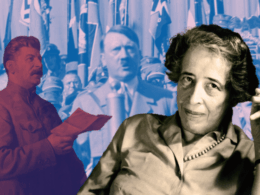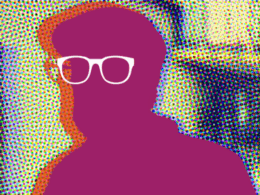Library of America fans who happen to be in the New York City area during the last days of 2015 and early 2016 are strongly encouraged to visit The Grolier Club on East 60th Street for a comprehensive exhibit dedicated to the life and work of the American artist Lynd Ward (1905–1985).
Ward is best known for the six innovative “novels without words”—books that tell their stories entirely through woodcut images—that he published between 1929 and 1937. Library of America reissued all six works in the two-volume boxed set Lynd Ward: Six Novels in Woodcuts, edited by Art Spiegelman, in 2010.
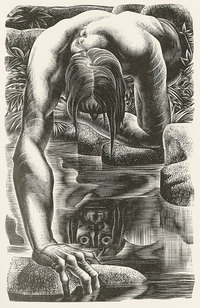
While the Grolier Club exhibition includes all six wordless novels, it also devotes equal space to Ward’s work in book arts and illustration, which encompasses wood engravings, dust jackets and other illustrations, fine press books, and, not least of all, classic children’s books like The Little Red Lighthouse and the Great Gray Bridge (1942). The show is a visual feast for bibliophiles, who will especially want to seek out—to cite just one example—the deluxe 1934 edition of Mary Shelley’s Frankenstein, for which Ward created fifteen full-page wood engravings.
Reached via email, exhibition curator Robert Dance shared some insights into Ward and his work with Library of America.
LOA: The entire Grolier Club exhibition is comprised of Ward artworks and objects from your collection—more than 60 in all. How did you come to be interested in the artist, and how many works by him—whether original art, printed books, or magazine tear sheets, etc.—would you estimate you own overall?
Dance: It was during a visit to the rare book room at The Strand bookstore about 30 years ago that I first encountered Lynd Ward. While I was looking at a shelf of books illustrated by Rockwell Kent, a clerk came by and asked about my interests. When I responded that I already had all the Kent titles they were offering in my collection, he asked if I was interested in Lynd Ward. He took a nice copy of the trade edition of Gods’ Man off the shelf and handed it to me. Having never heard of Ward, I was immediately intrigued. So began another collecting enthusiasm.
All these years later I have about 250 Lynd Ward books (including variant editions of several titles) and plenty of ephemera, some of which is exhibited at the Grolier Club, such as covers for The Atlantic magazine, illustrations for Look, and many of the political magazines and journals he illustrated throughout the 1930s and 1940s.
LOA: How did the exhibition come about? Was there a specific impetus or motivation for mounting it at this time?
Dance: For many years I have been hoping that a proper bibliography of Lynd Ward as a book illustrator would appear. None forthcoming, I decided to create a catalogue, arranged chronologically, for my own use. As the book grew and finally seemed to include all of Ward’s work as a book illustrator, I thought it should be published. I drafted a short biographical introductory essay to introduce the catalogue and titled it simply, Illustrated by Lynd Ward. As I was finishing up the project Library of America published the two-volume corpus of the novels in woodcuts. Soon after, filmmakers Michael Maglaras and Terri Templeton released a documentary on Ward, O Brother Man. Margery Cantor at the Impermanent Press in Norwich, Vermont asked if she might make a letterpress edition of my book.
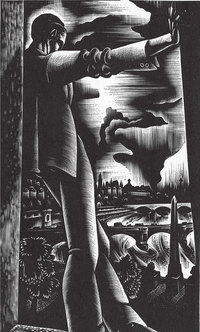
With all this Ward enthusiasm, I approached the chair of the Committee on Member’s Exhibitions at the Grolier Club about the possibility of a having a monographic show on Ward. The proposal was accepted, and the show opened in November. The Grolier Club has also published a trade edition of Illustrated by Lynd Ward.
LOA: We were especially interested to see that the exhibition extensively covers the decades of Ward’s career after the six “wordless novels” reprinted by LOA. How do you account for the dramatic changes his style undergoes in these later decades, from the 1940s through the ’70s?
Dance: The novels in woodcuts are the core of the show, and I am fortunate to have outstanding examples [of those books] in my collection for display. Ward was also a well-known children’s book illustrator with books to his credit such as Johnny Tremain, The Little Red Lighthouse and the Great Gray Bridge, and most importantly The Biggest Bear, which he both wrote and illustrated, and which won the Caldecott Medal in 1952. Although Ward was a master at wood engraving, he selected other printmaking techniques for children’s books such as lithography, watercolor, or crayon. These better suited works directed at children. Ward also illustrated many fine-press books including thirteen volumes for The Limited Editions Club. For his last LEC volume, Edmund Burke’s On Conciliation with the Colonies, he returned to wood engraving.
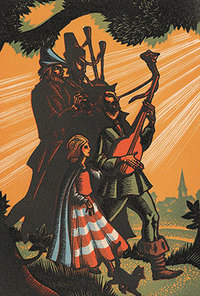
For me the delight in this show is the opportunity to show many dust jackets designed by Ward beginning in 1928. These brilliantly colored covers stand in strong contrast to the novels in woodcuts he created between 1929 and 1937, which in all but one case are printed in black.
Why Ward largely abandoned the novel in woodcut after the Second World War is a question I haven’t been able to answer successfully. We know, however, at the time of his death in 1985 he was working on another novel in woodcuts, and the completed blocks were collated and published posthumously as a book in a small edition entitled Lynd Ward’s Last Unfinished Wordless Novel.
Illustrated by Lynd Ward: From the Collection of Robert Dance remains on view at The Grolier Club in New York City through January 16, 2016. Visit grolierclub.org for complete exhibition information.
